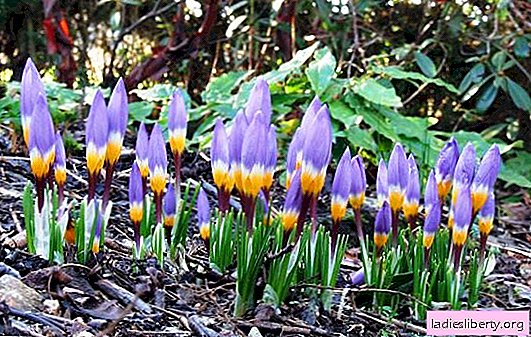
In early spring, crocuses are the first to open their fragile flowers. They stand out well on bare ground, attracting attention. With their help create bright clearings, which in spring begin a flowering parade. Fragile and delicate flowers do not need special care, but some rules must be followed when planting and care.
Description and characteristics of spring primrose, photo
Some varieties of crocuses are listed in the Red Book, they can be found in the mountains of the Crimea and the Caucasus. In gardening, hybrid crocuses of various colors are grown: blue, white, yellow, lilac and two-tone.
Crocus leaves grow in a bunch, appear simultaneously with the flower or later. Flowers bloom on a sunny day, and in cloudy weather or in the evening they are closed. The flowering period lasts up to one month, sometimes less. It is more dependent on the weather. Crocuses are small-bulbous plants whose height does not exceed 10 cm. The height of some hybrids can reach 15 cm. In most species, the flower is simple in a goblet shape, there are varieties with double flowers.

Bright and delicate crocuses are rightly called spring primroses. In order for branches to please their appearance, it is necessary to choose the corm on the right, on which the further development of the plant depends.
Crocus planting: how to choose a corm
The success of crocus cultivation depends on a properly selected planting material. Bulbs are better to buy in August or September, when they are at rest.
What to look for when buying:
• The bulb should not be loose and lethargic. Healthy planting material is dense and heavy.
• No sprouted roots or processes.
• Discard corms with mechanical damage. Pests and pathogens settle in them, which will lead to infection of the entire planting.
• On a healthy bulb, there are no traces of rot and dark spots.
Before planting crocuses, the bulbs are cleaned of old scales and disinfected. They are kept in a solution of potassium permanganate or sprinkled with ash.
Crocus cultivation: site selection for primrose
Before planting crocuses in the flower garden, it is worth choosing a suitable place where the plants will feel comfortable.
These flowers require space, as they grow rapidly. The crocus clearing should be well lit and warmed up by the spring sun. The flower is grown in open areas or under trees, where in spring there is enough light for growth and development.
In modern design use group plantings of crocuses on lawns, lawns or in the garden. Florists often grow crocuses on a Moorish lawn. The main condition is good lighting, only then the earth will quickly warm up after the snow melts, and crocuses will please with beautiful flowering.
What soil is needed to plant crocuses
These flowers are neutral to the soil, but do not tolerate wetlands and stagnant water. The flower grows well on loam and sandy loamy soils. Nutrient additives in the form of mineral fertilizers are added to too depleted soil.
When crocuses are planted in open ground, the holes are seasoned with rotted manure and humus. Drainage in the form of crushed stone, gravel or crushed brick is laid at the bottom of the landing pit. Sand and peat are added to heavy soil.
Crocuses tolerate drought well, but an excess of moisture leads to decay of the roots, so when planting we must not forget about drainage. This is one of the important conditions when growing crocuses in open ground.
When to plant crocuses in the garden (photo)
Much depends on the correct landing dates. Late planting leads to the fact that the unrooted bulb freezes in the winter. If planted too early, plants can sprout even before winter and die.
Planting dates depend on the variety of crocuses that are grown in the garden. There are autumn-flowering and spring-flowering plants. Planting depth depends on the size of the bulb.

Autumn-blooming hybrids are planted in the spring. The optimal landing period is from early May to early June.
Spring hybrids are planted in the fall, from the second half of September until the end of October.
Many nurseries sell autumn-blooming crocus hybrids in bloom. Planting such a flower should take place according to special rules.
1. At corms cut off all the leaves and peduncles. That will allow the plant to adapt to new conditions much faster.
2. In the year of planting, flowering is most likely not to come, but next year it will be brighter.
You need to buy crocuses before flowering, as it greatly depletes the plant and it takes a year to recover. Further growth and development is greatly slowed down.
What care does crocus need (photo)
A flower like crocus does not require special care. It is enough to fertilize it in a timely manner and dig out the bulbs. In the summer, the plant does not need abundant watering.
Crocus is better to fertilize in the period of active growth - in the spring. Granules of mineral fertilizers are scattered directly on the snow, which fall into the soil and gradually nourish the flower. It is also useful to feed crocuses with organic fertilizers. Apply humus and peat. During the flowering period, it is useful to introduce phosphorus-potassium fertilizing.
Crocus propagation
Crocuses form daughter bulbs, which are planted from the mother plant. This method of propagation allows you to fully preserve all varietal qualities of a young flower.
Transplantation of daughter bulbs is carried out every four years. In this case, the number of children directly depends on the size of the maternal bulb. The larger it is, the more children are formed on it. Shallow planting will help increase the number of daughter bulbs. Young plants after transplantation bloom after a few years.

It is not worth neglecting the transplant, otherwise the flowers and bulbs of the crocuses become smaller, or even completely disappear.
Why dig bulbs
When caring for crocus, we must not forget about the excavation. It is carried out depending on the plant variety. It is recommended to dig out crocuses annually, after the leaves have completely dried out and the dormant period sets in.
After digging the bulbs are sorted and rejected sick and damaged. Then they remove old scales, the remains of the roots and lay them in storage. Bulbs should be stored in a well-ventilated area at temperatures up to 20 degrees until planting.
Growing crocuses without digging leads to thickening of nests, diseases and lack of flowering.
Problems in growing crocuses in the open ground (photo)
All bulb plants have their weaknesses.
• viral infections;
• fungal infections;
• spoilage by rodents.
Planting damaged corms leads to infection with viral diseases, which are manifested by bright spots on the leaves and buds. The flowers become ugly and do not open. Such plants are rejected, and the planting site is treated with disinfectants.
Poor care and non-compliance with the conditions for growing crocuses leads to fungal diseases. The bulbs soften and become unusable. As a prophylaxis, corms are dried and stored by special means before storage.
The main pests of bulbous plants are mice, hares and other rodents. They find bulbs, dig, eat. Often for planting crocuses and other bulbs, special baskets are used that protect plants from rodents.












